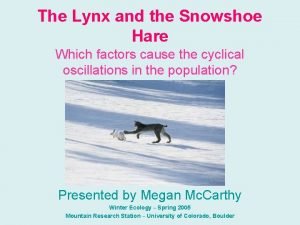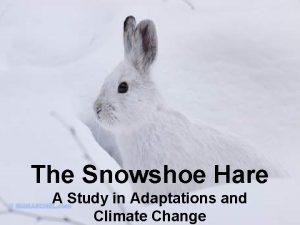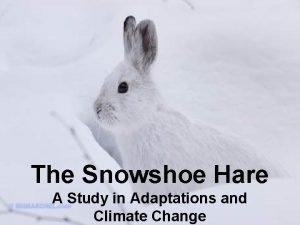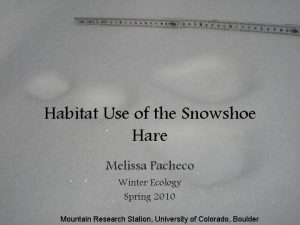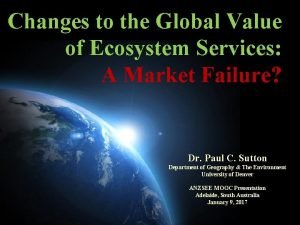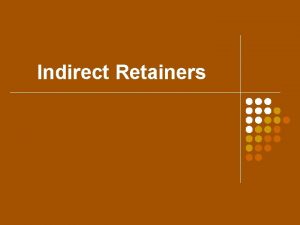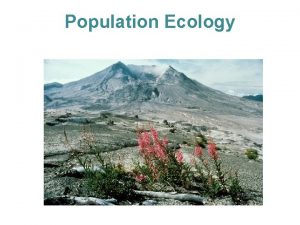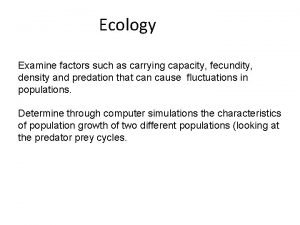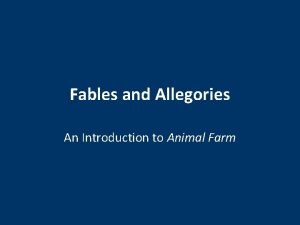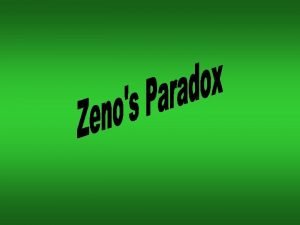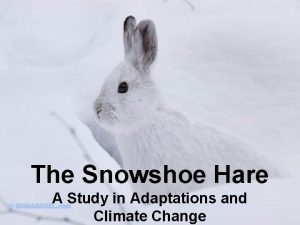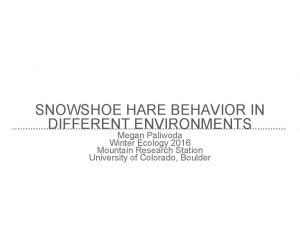2 6 Ecosystem Changes Snowshoe Hare and Canada


















- Slides: 18

2. 6 Ecosystem Changes

Snowshoe Hare and Canada Lynx

Population Growth Population: a group the same species that live in the same place at the same time Resources: food, water, shelter, space and mates In theory populations can grow to an infinite size, but they are limited by resources This causes individuals to compete for resources (remember intraspecific and interspecific competition!).

Factors that Control Populations There are 4 main factors controlling population sizes: Natality - births increase the population Mortality - deaths decrease the population Immigration - movement of individuals into an area increases the population Emigration - movement of individuals out of an area decreases the population

Carrying Capacity Carrying capacity: maximum number of individuals of a species that can be sustained indefinitely in a given space No population can grow indefinitely! Resources = Limited!!

Limiting Factors of Populations Factors (biotic or abiotic) which prevent population numbers from growing too large and overrunning an ecosystem. Example: Disease/ parasites disasters hunting & predation competition for resources (food, oxygen, nutrients)

Patterns of Population Growth “J” population growth curve Exponential growth = starts out slow and then proceeds faster and faster Occurs when a population has few resource limitations Sudden collapse ('diebacks')

Patterns of Population Growth “S” growth curve (S for sigmoid) Initially shows exponential growth then levels off at the carrying capacity. Occurs when a population has limited resources. Results in stable population

J Curve vs. S Curve

Population Dynamics A look at the factors that tend to increase or decrease the size of a population The population size is determined by the interplay of biotic potential and environmental resistance. Biotic potential- growth rate with unlimited resources Environmental resistance - all the factors acting jointly to limit population growth

Biotic Potential vs. Environmental Resistance Biotic potential (Growth Factors) Favorable light, temperature High reproductive rate Adequate food supply Ability to migrate habitats Ability to adapt to environmental change Environmental resistance (Decrease Factors) Too much or too little light and temperature Low reproductive rate Inadequate food supply Inability to migrate habitats Inability to adapt to environmental change

Biotic Potential vs. Environmental Resistance

Density Dependent Factors Density dependent factors Depend on the size of the population Effects of the factors increase as the population grows Act as negative feedback Tend to be biotic Two categories: Internal factors = Within a single species limited resources reduced fertility rates External factors = between species populations of predators or prey diseases spread more easily in densely-populated areas

Density Independent Factors Do NOT depend on the size of the population Tend to be abiotic Effect the population regardless of its size Examples: 1. Weather 2. Earthquakes 3. Floods 4. Fires R-strategists are most affected by these factors

Reproductive Strategies r Unstable environment Small size Many offspring are produced Early maturity Short life span Each individual reproduces once Type III survivorship curve Affected by density Independent K Stable environment Large size Few offspring produced Late maturity (long parental care) Long life span Individuals reproduce more than once Mostly type I survivorship curve Affected by density dependent

Survivorship Curves Type I - high survival rate of the young, live most of their expected life span and die in old age. (ex. Humans) Type II - relatively constant death rate, could be due to hunting or diseases. (ex. coral, squirrels, honey bees and many reptiles) Type III - have many young, most of which die very early in their life. (ex. plants, oysters and sea urchins).

Survivorship Curves

Pop Quiz What does parental care have to do with the shape of these curves? What density dependent factor will always affect the population of white tailed deer in NYS? (Only at certain times in the year) What do you think the survivorship curve would be for a white-tailed deer population?
 Snowshoe hare lynx
Snowshoe hare lynx Hares adaptations
Hares adaptations Snowshoe hares adaptations
Snowshoe hares adaptations Snowshoe hare niche
Snowshoe hare niche Hare rama hare krishna
Hare rama hare krishna Changes in the global value of ecosystem services
Changes in the global value of ecosystem services Changes in the global value of ecosystem services
Changes in the global value of ecosystem services Changes in latitudes, changes in attitudes meaning
Changes in latitudes, changes in attitudes meaning Examples of chemical change
Examples of chemical change Principles of removable partial denture design
Principles of removable partial denture design Indirect retainer fulcrum line
Indirect retainer fulcrum line The tortoise and the hare characters
The tortoise and the hare characters Lynx and hare relationship
Lynx and hare relationship Lynx and hare relationship
Lynx and hare relationship Lynx and hare relationship
Lynx and hare relationship Tortoise and the hare allegory
Tortoise and the hare allegory Hare and tortoise paradox
Hare and tortoise paradox Jugged hare poetry analysis
Jugged hare poetry analysis Hoppe hoppe hare text
Hoppe hoppe hare text
